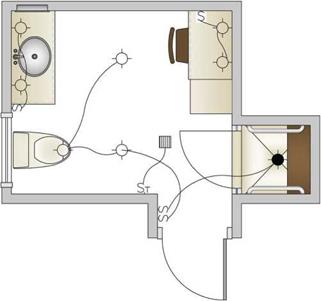Lighting fixtures (luminaires) come in a wide variety of styles, mounting types, and sizes. When deciding which type to use in your bathroom, consider the size of the space you are lighting, the type of light you want emitted, the design theme of the space, and the tasks that must be illuminated. Following are a few important points to consider concerning light fixtures.
Location and Type
Locate the fixtures where they can deliver the maximum amount of light for their purpose. General lighting might involve one or two lights in the center of the room, or a number of lights around the perimeter. Provide enough light so that dark corners do not form. Do not use fixtures that can get into the way of the users. For example, wall sconces in the walkways of very small bathrooms, or central ceiling fan lights in average height ceilings, may be easily bumped by the user. General lighting can be provided by many types of fixtures. Center room fixtures can be ceiling mounted or hanging, such as a chandelier. A light may also be part of the ventilation system and provide general lighting in a small bathroom.
Don’t forget to place some general lighting in all compartments of the bathroom, as well as in the shower and over the tub. According to Bathroom Planning Guideline 25 and most local building codes, hanging fixtures cannot be located within a zone of 3 feet (914.4 mm) horizontally and 8 feet (2439.4 mm) vertically from the top of the bathtub rim. Lights in the tub and shower areas should be "suitable for damp/wet locations."
When lighting a task area, the fixture should be mounted so it casts light onto the task area without creating a shadow or causing glare, and light the user’s face and not the top of his/her head. For the best quality lighting while grooming, applying make-up, and shaving you would ideally want lights all around the mirror, such as with "Broadway" style lighting. This might not always be practical and may not fit the design plan of the client. The next best option for optimum lighting quality would be to place light fixtures to each side of the user’s face. Fixtures located only above a mirror, like with "Hollywood" lights, cast shadows onto the user’s face, whereas lamps at the sides of the mirror eliminate such shadows. Use the user’s eye height measurement to guide where side lighting is placed and mount them at least 30 inches (762 mm) apart. These side lights could be wall-mounted sconces, pendants, or vertical fluorescent bars for good cross illumination. The fixture’s lamps should be bright enough for the user to easily see what they are doing, but not be visible to the user so as to create glare.
 FIGURE 7.18 Bathrooms should include general and task lighting (Bathroom Planning Guideline 25). All of the bathroom’s lighting needs should be illustrated on the mechanical plan.
FIGURE 7.18 Bathrooms should include general and task lighting (Bathroom Planning Guideline 25). All of the bathroom’s lighting needs should be illustrated on the mechanical plan.
NKBA
Place rope lighting behind ceiling moulding that is dropped a few inches from the ceiling to create a soft glow at the ceiling. Rope lighting in the toe-kick area makes a good night light. Recessed lights can be used for general lighting or lighting at individual fixtures.



